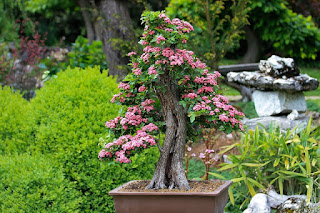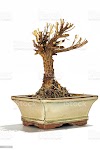BONSAI TREE POTS:
Bonsai pot
It is said that among bonsai enthusiasts, the question of whether the pot is first or the tree first is endless.
There are many collectors of pots with high antique value, and some are keen on tree making and are not very interested in pots.
This is not the correct answer, but the “bon” of a bonsai refers to a pot, and the “sai” refers to a tree.
Trees are the only bonsai that seems to be the leading role, but pots and tables, side arrangements, and accompanying wildflowers also have meaning in the decoration seats.
No matter how good the bonsai is, if the pots that are planted are not matched or the whole is not in harmony, the appreciation value will drop and even the quality of the decorator will be questioned
Bonsai pot conditions
① Good air permeability
The roots support the aerial parts and absorb moisture and nutrients in the soil, but at the same time breathing, so the ventilation of the pot is important.
Good ventilation improves heat dissipation and regulates the temperature inside the bowl.
Even when using a well-ventilated soil, if planted in a pot with glaze or a pot that has been baked firmly with fine earthenware, the water in the pot will not escape and root growth and other poor growth will occur...
The dressing bowls are enjoyable for display purposes and are ideally managed in tailor-made bowls that take into account ventilation.
②Good water retention and drainage
Adequate water retention and drainage are necessary conditions for plant growth.
These depend on the quality of the clay, how it is baked, the location and size of the bottom hole, the structure of the pot, and the presence or absence of glaze used as a medicine.
The glaze is a slippery glassy part that hangs over the surface of the pottery. It is made by dissolving powder of clay mixed with metals such as lime, iron, body, and cobalt in water.
Glaze melts when it is baked at a high temperature, giving it various colors and preventing water leakage.
On the other hand, drainage and air permeability deteriorate, and it is good for viewing, but not very good for growing trees.
If you keep a tree planted in a glazed pot, the roots will gradually weaken.
It is possible to grow well with tailoring pots by properly devising irrigation and soil, but it is safer to use tailoring pots unless you are used to daily management.
③ Absorb solar heat
The temperature in the potting soil is important for root development.
In order to achieve this, it is necessary to select a bowl that absorbs heat well.
The best ones are roasting pots and unglazed pots.
④Appropriate shape and size
This can be said from an aesthetic point of view, but it goes without saying that you choose a pot that has a shape that matches the bonsai.
If the shape is distorted, the bottom of the pot is not flat, or the bottom hole is opened in a strange place, it will impair the ventilation and drainage.
Pots that are too deep cannot be said to be very good because the temperature of the soil is difficult to rise, and unstable pots are not good because they fall down and break off the branches and easily fall out of the pot.
Sometimes people use pots that are too large for the tree, but if they are put in too large pots, they will not fit when trying to put them in the main pot, and it will be necessary to arrange a lot of roots The damage is great.
If you are not going to get fat, please keep it in a size that can be easily put in the bowl.
When it comes to shapes, there are many different types of pots to match depending on the tree shape and tailoring, and there are countless shapes of pots that can be subdivided.
The best pots for the tree species and tree shape will be squeezed, such as a mud square bowl for patterned pine and a shallow elliptical glazed pot for broom-making zelkova.
Think about bowl
There are many types of bowls, and I think it's really fun to choose your favorite.
However, the shape of the pot that matches the shape of the tree, such as the thick stem is a slightly deeper pot and the thin stem is a slightly shallower pot, is almost decided.
If the size of the pots is not harmonious, the tree will become a strange bonsai, and pine trees are not very common with patterns and glaze pots.
The first pot match is to have fun, but consider the appropriate shape and color of the pot based on the tree species and tree shape, and try to combine the pots and plants so that they can be seen together.
How to choose pots by tree type
Bowl to match pine wood
Mud, such as vermilion or purple mud, is often used to enhance the strength and foliage of pinewood, and it also looks good.
Mud has excellent functions such as ventilation, drainage, and heat absorption, and is suitable for growing trees.
Pots to match flowers, real and leaves
Glazed objects look great.
Those who enjoy autumn leaves and fruits prefer blue-colored pots, and those who enjoy green leaves prefer white or yellow-colored pots.
If you choose flowers with complementary colors of flowers and pots, the flowers will stand out.
Also, choose a slightly deeper bowl for the real thing, and imagine the harmony when it comes to fruition.
How to choose a pot by tree shape
Pot shape suitable for the straight trunk, double trunk, doubletree
If the stem pattern is firm and the branch swings are well made, it is easier to balance with a slightly deeper rectangular or elliptical bowl.
It is better to plant trees with shallow roots such as zelkova, maple, and cedar in a shallow pot to show the roots.
Diagonal trunk, the shape of the pot to match the pattern tree
Long pots and elliptical pots go well.
If you have a heavy patterned wood, use deeper pots to balance it.
Depending on the stem pattern, such as making a delicate literary person, a shallow round bowl is suitable.
The shape of a bowl that fits a literary tree
Round and square bowls with a light impression are suitable for delicate literary trees with a small number of branches.
You can combine a bowl with high design, such as a cup-shaped bowl or elaborately made legs, for a stylish look.
Take a look at the flow of the tree and approach it to either side to make room.
Potted, pot-shaped for rooting
Suitable for long and shallow rectangular bowls and elliptical bowls.
If the plant is flowing, place it on either side to create a margin.
Bowl shape that fits a cliff, semi-cliff
A deep square or round bowl is suitable.
When planting vine plants, use tall lower pots as long vines and fruits hang down.
The shape of a bowl that fits with a stone
Bonsai is a type of bonsai that is planted and planted on natural stones resembling rocky shores and quays.
The stones to be used are preferably undulating, changing, and interesting shapes reminiscent of rough mountains and cliffs.
Typical stones suitable for bonsai include Ryuganseki, which has many standing stones, and Kurama stone, which has many flat stones.
In some cases, pumice is used at a low price and it is easy to process, but it is not suitable for full-scale bonsai because its shape easily collapses. We want to avoid artificially shaved or mixed concrete as much as possible.
The basics of decoration are to lay bonsai with stones on the ground plate or shallow basin, lay the sand, and watch it.








0 Comments
plz do not any spam link in the comment box.